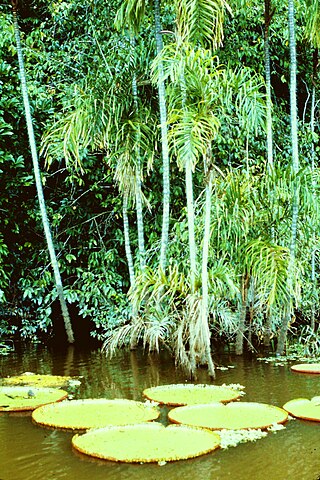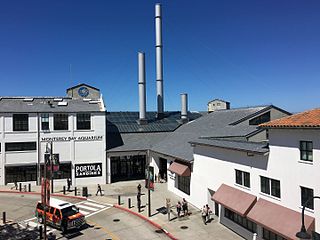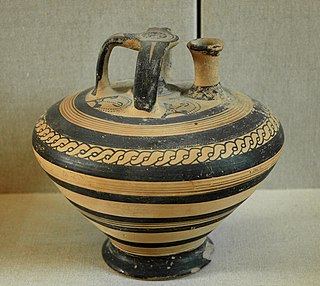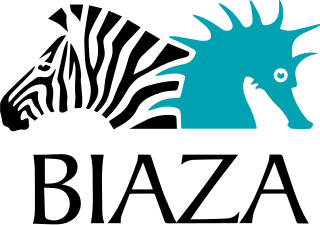Related Research Articles

A biotope is an area of uniform environmental conditions providing a living place for a specific assemblage of plants and animals. Biotope is almost synonymous with the term "habitat", which is more commonly used in English-speaking countries. However, in some countries these two terms are distinguished: the subject of a habitat is a population, the subject of a biotope is a biocoenosis or "biological community".
London Zoo, previously known as ZSL London Zoo or London Zoological Gardens and sometimes called Regent's Park Zoo, is the world's oldest scientific zoo. It was opened in London on 27 April 1828, and was originally intended to be used as a collection for scientific study. In 1831 or 1832, the animals of the Tower of London menagerie were transferred to the zoo's collection. It was opened to the public in 1847. As of Dec 2022, it houses a collection of 14,926 individuals, making it one of the largest collections in the United Kingdom.

Monterey Bay Aquarium is a nonprofit public aquarium in Monterey, California. Known for its regional focus on the marine habitats of Monterey Bay, it was the first to exhibit a living kelp forest when it opened in October 1984. Its biologists have pioneered the animal husbandry of jellyfish and it was the first to successfully care for and display a great white shark. The organization's research and conservation efforts also focus on sea otters, various birds, and tunas. Seafood Watch, a sustainable seafood advisory list published by the aquarium beginning in 1999, has influenced the discussion surrounding sustainable seafood.

An artifact or artefact is a general term for an item made or given shape by humans, such as a tool or a work of art, especially an object of archaeological interest. In archaeology, the word has become a term of particular nuance and is defined as an object recovered by archaeological endeavor, which may be a cultural artifact having cultural interest.

The Columbus Zoo and Aquarium is a non-profit zoo located near Powell in Liberty Township, Delaware County, Ohio, United States, north of the city of Columbus. The land lies along the eastern banks of the O'Shaughnessy Reservoir on the Scioto River, at the intersection of Riverside Drive and Powell Road. It has a worldwide reputation, largely attributable to the efforts and promotion of director emeritus Jack Hanna. In 2009, it was named by the USA Travel Guide as the number one zoo in the United States. It was also ranked number one best zoo in 2012 by Besties Readers Choice.

The Waikīkī Aquarium is an aquarium in Honolulu, Hawaii, United States. It was founded in 1904 and has been an institution of the University of Hawaiʻi at Mānoa since 1919. The aquarium is the second-oldest still-operating public aquarium in the United States, after the New York Aquarium.

The Detroit Zoo is a zoo located in the cities of Huntington Woods and Royal Oak in the U.S. state of Michigan. Spanning 125 acres (50.6 ha), it houses more than 2,000 animals and more than 245 different species. It was the first U.S. zoo to feature bar-less habitats, and is regarded to be an international leader in animal welfare, conservation and sustainability by the Detroit Zoological Society.

In biology, detritus is dead particulate organic material, as distinguished from dissolved organic material. Detritus typically includes the bodies or fragments of bodies of dead organisms, and fecal material. Detritus typically hosts communities of microorganisms that colonize and decompose it. In terrestrial ecosystems it is present as leaf litter and other organic matter that is intermixed with soil, which is denominated "soil organic matter". The detritus of aquatic ecosystems is organic material that is suspended in the water and accumulates in depositions on the floor of the body of water; when this floor is a seabed, such a deposition is denominated "marine snow".
Bioculture is the combination of biological and cultural factors that affect human behavior. Bioculture is an area of study bounded by the medical sciences, social sciences, landscape ecology, cultural anthropology, biotechnology, disability studies, the humanities, and the economic and global environment. Along these lines, one can see the biosphere — the earth as it is affected by the human — as the adaptation of the natural to the human and biocultures as the inter-adaptation of the human to the new technologies and ways of knowing characterized by the 21st century’s attitude toward the body. It assumes that in bioculture there's a diverse way to know the workings of the body and mind, and that these are primarily culturally derived, and an expert's way of knowing produces specific strong results. However the results do not have an exclusive purview over the body and mind. Plus it seeks to develop and encourage not only the experts but also parts of people's bodies and minds as the subject of study.

The Rosamond Gifford Zoo at Burnet Park is an AZA zoo in Syracuse, New York. It is owned and operated by Onondaga County Parks with support from the Friends of the Rosamond Gifford Zoo. The zoo is home to more than 900 animals representing 216 species on 43 acres (17 ha). Some of the more popular animals include Asian elephants, Humboldt penguins, Amur tigers, a Komodo dragon and the only Giant Pacific octopus exhibit in Central New York. The zoo opened a new Animal Health Center in 2022 that is the largest zoological medical center in New York state outside of the Bronx Zoo.
The Sequoia Park Zoo is a zoo located in Eureka, California, operated by the City of Eureka. The zoo is part of a larger park complex including 60-acre (24 ha) of mature second-growth coast redwood forest, Eureka's largest public playground, and a duck pond, in addition to formal and natural gardens. The gardens include many varieties of rhododendron. The zoo's mission is "to inspire wonder, understanding and respect for the natural world by providing fun, rewarding, educational experiences that encourage meaningful connections between animals, humans, and our environment". The zoo is open to the public daily, except in winter when it is closed on Mondays. The zoo houses about 200 vertebrates and hundreds of invertebrates, representing about 54 different species on 7-acre (2.8 ha).

Paignton Zoo is a zoo in Paignton, Devon, England. The zoo is part of South West Environmental Parks Ltd which is owned by the charity Wild Planet Trust, formerly known as the Whitley Wildlife Conservation Trust. The charity also runs Newquay Zoo in Newquay, Cornwall, and ran Living Coasts in Torquay, Devon until its closure in 2020.

The World Association of Zoos and Aquariums (WAZA) is the "umbrella" organization for the world zoo and aquarium community. Its mission is to provide leadership and support for zoos, aquariums, and partner organizations of the world in animal care and welfare, conservation of biodiversity, environmental education and global sustainability.

The British and Irish Association of Zoos and Aquariums (BIAZA) is a registered charity and the professional body representing over 100 zoos and aquariums in Britain and Ireland.

A zoo is a facility in which animals are kept within enclosures for public exhibition and often bred for conservation purposes.

A public aquarium (pl. aquaria) or public water zoo is the aquatic counterpart of a zoo, which houses living aquatic animal and plant specimens for public viewing. Most public aquariums feature tanks larger than those kept by home aquarists, as well as smaller tanks. Since the first public aquariums were built in the mid-19th century, they have become popular and their numbers have increased. Most modern accredited aquariums stress conservation issues and educating the public.

Living Coasts was a coastal zoo at the site of Torquay Marine Spa in Devon, England. It was owned by South West Environmental Parks as part of the Wild Planet Trust, formerly known as Whitley Wildlife Conservation Trust, which also operates Newquay Zoo and Paignton Zoo. It was a registered charity, based around seabirds and other coastal wildlife. The site had a covered giant aviary which included several animal enclosures and habitats including an artificial tidal estuary, a penguin beach, a tropical mangrove swamp, and underwater viewing areas.
The Zoo and Aquarium Association Australasia (ZAA), based in Sydney, Australia and Wellington, New Zealand, is an association of zoos, aquariums, sanctuaries and wildlife parks across Australia, New Zealand, Papua New Guinea and the South Pacific Islands, whose central goal is to support and verify animal welfare among its members and in the wild.

In archaeology, a biofact is any organic material including flora or fauna material found at an archaeological site that has not been technologically altered by humans yet still has cultural relevance. Biofacts can include but are not limited to plants, seeds, pollen, animal bones, insects, fish bones and mollusks. The study of biofacts, alongside other archaeological remains such as artifacts are a key element to understanding how past societies interacted with their surrounding environment and with each other. Biofacts also play a role in helping archaeologists understand questions of subsistence and reveals information about the domestication of certain plant species and animals which demonstrates, for example, the transition from a hunter-gatherer society to a farming society.

An aquarium is a vivarium of any size having at least one transparent side in which aquatic plants or animals are kept and displayed. Fishkeepers use aquaria to keep fish, invertebrates, amphibians, aquatic reptiles, such as turtles, and aquatic plants. The term aquarium, coined by English naturalist Philip Henry Gosse, combines the Latin root aqua, meaning 'water', with the suffix -arium, meaning 'a place for relating to'.
References
- ↑ Bostock, Stephen St C. (2003-09-02). Zoos and Animal Rights. Routledge. ISBN 9781134942459.
- ↑ "New England Aquarium Animal Adaptions" (PDF).